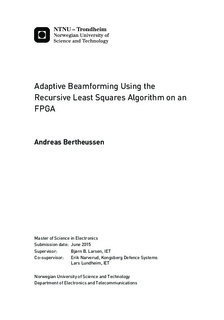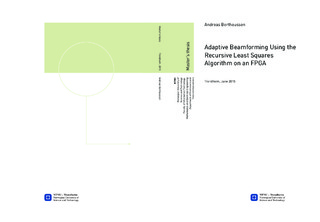| dc.description.abstract | This thesis describes the design and implementation of a five-channel beamformer using a Space-Time Adaptive Processing (STAP) filter with Recursive Least Squares (RLS) as the adaptive algorithm. The objective of the algorithm is to compute of a set of filter weights for a STAP filter, such that the channels are filtered and combined into a signal with minimized power. Two test signal sets containing a high-powered jammer signal and a noise floor are used for performance evaluation. Three goals are set for this thesis; comparison of RLS to Sample Matrix Inversion (SMI) algorithm when used in a beamformer, comparison of various architectures which implement RLS, and the implementation and test of one of the architectures for a Xilinx Virtex 6 XC6VLX240T-1 Field-Programmable Gate Array (FPGA)
Simulations comparing RLS to SMI show that a beamformer using RLS performs the same as a beamformer using SMI for 3-5 antennas (channels) and 1-4 temporal taps in the STAP filter.
Litterature review shows that conventional RLS is unsuitable for FPGA implementation due to numerical instability. Comparison of IQRD-RLS, FQRD-RLS and MCFQRD-RLS architectures which are claimed to be stable RLS variants, shows that IQRD-RLS is the least computationally expensive of the algorithms.
IQRD-RLS is implemented using Givens rotations in a systolic array architecture. Floating point, fixed point and CORDIC-based Givens rotation algorithms are compared with regard to speed and area, and floating point is chosen. Hardware simulations reveal that the filter weights returned by IQRD-RLS exhibit a drift, and is not stable in finite-precision arithmetic. The main cause is accumulated quantization error from the forgetting factor and its inverse (λ^(+-1/2)).
The IQRD-RLS systolic array is reduced to a (stable) QRD-RLS systolic array, approximately halving the number of systolic array nodes. Filter weights are not computed directly by QRD-RLS, and are instead recovered from the QRD-RLS least squares filtering error output by the method of weight flushing.
Results show that the QRD-RLS systolic array using 14 mantissa bits is sufficient as it performs equivalently to conventional RLS using double precision (53 mantissa bits). If only 11 mantissa bits are used, the output power increases by 3.3 dB. The final design can operate at sample rates from 19.4 MHz to 24.6 MHz, for a mantissa precision range of 14 to 11 bits. At this rate, the QRD-RLS systolic array can converge and output filter weights in 5.3 µs, significantly faster than the target of 100 µs. It is found that the current design has fully utilized its speed potential/limit due to the recursive nature of the algorithm. Processing of signals at the desired rate of 125 MHz would require changes to the algorithm itself. The implementation size is such that a 5-channel QRD-RLS array with one tap can fit on the FPGA. Channel-interleaving is proposed as a method to reduce system size, at the expense of slower operation.
All hardware is designed, simulated and tested using Simulink together with Xilinx System Generator and its co-simulation and hardware-in-the-loop features. | |

